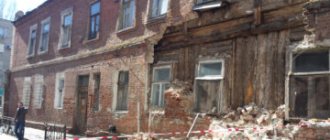Many people believe that a dilapidated house is an old, destroyed building with broken windows and a dilapidated roof. And, although such a building is unsuitable for human life, it is not a very accurate example of the emergency state of the house.
The fact that a building is not new and shabby does not mean that it poses any danger. There are many old buildings that are in good condition and completely safe, such as architectural and historical monuments that are considered tourist attractions and are visited by millions of people.
On the contrary, there are many relatively new houses that were built very recently, but are unsafe for people due to, for example, poor-quality foundations or weak, cracking walls.
But a building is considered unsafe if living in it is dangerous due to damage to the main load-bearing structures, such as:
- roof;
- walls;
- foundation;
- various ceilings and partitions.
Attention
Such a structure must be officially registered in a special register and demolished. But how to recognize a house as unsafe and why do it?
New housing
A building declared unsafe is subject to demolition, but what then are the citizens who previously lived in it left with?
One of the possible options is that they can be relocated to another place by participating in a relocation program for emergency housing. It came into force on January 1, 2021 and allows many people to find new, secure housing by providing them with subsidies and favorable rental contracts. Program conditions vary slightly from subject to subject.
At the same time, there are no plans to resettle dilapidated houses, because in most cases repair work can be carried out in them, which will significantly improve the condition of the premises and extend its service life. Only residents of those buildings that will soon be demolished will be resettled because they pose a threat.
Important!
To find out whether his home is participating in this program, a citizen must contact the Local Government Administration of the city in which he lives. Resettlement does not always occur with money from the state treasury. It can also be paid for by the Local Government Administration, sometimes with the help of investors.
In addition, a person who does not want to wait for relocation under the program can try to resolve the issue on his own by filing a lawsuit in court, demanding the provision of safe housing to replace the existing unsafe one.
A citizen who chooses this method can count on a room whose area is no less than the area of the previous one, and the number of rooms in which, again, is no less than in the previous housing.
A person may refuse to receive housing and receive a certain amount of money instead.
General aspects
In the Russian Federation, a program for the demolition of dilapidated housing has been operating for quite a long time. But due to the rather slow implementation of the program, a small number of citizens were resettled.
In accordance with the terms of the program, resettlement occurs as follows:
- Formation of a regional program, the goal of which is to eliminate dilapidated housing.
- Creation of a list of emergency and dilapidated housing.
- Making a decision on the complete demolition of the house or its reconstruction.
- In the event of the proposed demolition of a building, searching for equivalent living space.
As a rule, living space is selected in the same place where citizens previously lived.
But at the request of citizens and on the basis of an application received from them, a decision can be made to relocate to another place of residence.
Every citizen has the right to clarify information about the inclusion of his home in the list of emergency housing.
To do this, you need to go to a special government website. Instead of new housing, the owner of the emergency premises may be given compensation.
But it must be borne in mind that relocation due to a house in disrepair is in no way a way to improve living conditions. When allocating housing provided, the area of the previous home is taken into account.
And the citizen will receive exactly as many square meters as he had. And no accounting standards play a role here.
If a person wants to get housing of a larger area, then he will have to pay for the extra square meters with personal funds. As for the type of housing, there are also no strict parameters.
These could be apartments in new buildings or secondary real estate. The main requirement is that the housing provided should not be in emergency condition.
Basic Concepts
When it comes to housing accidents, two main definitions should be distinguished. This housing is “unsafe” and “dilapidated”.
This is by no means the same thing, as some ill-informed citizens think. Depending on the official status of the building, what consequences will occur.
The main difference is that residents from a dilapidated building must be resettled, while those from a dilapidated building should not. A building is considered unsafe if it is unfit for habitation in principle.
That is, there are structural deformations, the house is located in a dangerous area, or sanitary requirements are seriously violated.
Living in a dilapidated house is dangerous. In some cases, if a house is recognized as unsafe, urgent resettlement of citizens and demolition of the building is required.
Dilapidated housing cannot be called comfortable either. But living there is not life-threatening.
Even if the house is recognized as 70% dilapidated, but there is no threat of destruction or the living conditions do not threaten the health of citizens, then there are no reasons for urgent resettlement.
That is why many houses in terrible condition continue to be used, waiting until they are recognized as unsafe.
Building evaluation criteria
The grounds for recognizing housing as unsafe are given in Decree of the Government of the Russian Federation No. 47. These are:
This is important to know: Complaint against GORGAZ to the prosecutor's office
| Location of the object in the area with predisposition | To landslides, avalanches, mudflows, floods |
| Location of the building in the area | Where there is a high probability of destruction due to man-made accidents |
| Placing a house too close | To AC power lines |
| Damage to the structure as a result | Geological phenomena with the impossibility of restoring the object |
| Location of the building near the highway | When noise levels exceed permitted standards (no more than 55 decibels) |
| Violation of hygiene requirements | And sanitary and epidemiological standards |
| Major deformation of the foundation | Or load-bearing structural elements |
Not the entire apartment building, but only part of it, may be considered unsafe. For example, a separate residential premises is recognized as unsafe due to the failure of the interfloor ceiling.
Legal standards
The problem with dilapidated and dilapidated housing in Russia is very acute. For this reason, since 2010, according to the Presidential Decree, a targeted program “Resettlement of citizens from emergency housing stock” has been in effect.
Initially, the program was scheduled to end in 2015, but it was later extended until September 31, 2017.
Further, the program will continue its operation within the framework of regional programs. The main goal of the program is the resettlement of citizens from housing that does not meet safety standards.
By virtue of Article 14 of the Housing Code of the Russian Federation, declaring housing unfit for habitation falls within the competence of local government bodies.
Thus, citizens have the right to demand that local authorities inspect their housing if there are grounds to recognize it as unsafe.
When and to whom can you apply for recognition of a house as unsafe?
Any owner who believes that the building in which his apartment is located is unsafe to live in can submit such an application.
In order for an examination of the condition of the building to be carried out, an application from just one person is sufficient, but the cost of this procedure is quite high, so it is advisable to submit an application to several people at once.
If the examination confirms that the house is unfit for habitation and cannot be repaired, the local interdepartmental commission will recognize it as unsafe.
For this you will need the following documents:
- registration certificate for the house;
- checking act;
- state housing inspection;
- examination findings indicating the poor condition of the house.
Important!
It is important to remember that recognition of a building as unsafe most often occurs on the initiative of citizens, so you should not wait until the administration takes care of it. Inspecting the condition of residential buildings is indeed part of her powers, but often she cannot initiate examinations, and even when this happens, such actions often run counter to the interests of the residents themselves.
Recognition procedure
How to recognize housing as dilapidated and unsafe? A house is declared unfit for habitation in accordance with Section IV of Resolution No. 47.
This is important to know: Act on improper maintenance of common property: sample
1. Submission of documents and applications
To begin the procedure, you must submit an application.
In an apartment building, you can first hold a meeting of residents and vote on recognizing the building as unsafe (dilapidated).
Who can apply:
- tenant of the house (owner or social tenant);
- municipality;
- control authorities (Rospotrebnadzor, fire inspection, etc.).
Residents can apply:
- To the administration.
- Housing inspection (will issue an opinion and transfer it to the interdepartmental commission).
- Interdepartmental commission. To apply directly, additional costs will apply. It is necessary to order an inspection of the technical condition of an apartment building from a specialized organization. The organization will issue a conclusion, which is submitted to the commission
The interdepartmental commission makes a decision (clause 47 of resolution No. 47):
- about the suitability of the house for habitation;
- the need for major repairs, reconstruction or redevelopment;
- unsuitability of the house for habitation;
- recognition of an apartment building as unsafe and subject to reconstruction or demolition.
The acceptance period is 30 days (clause 46 of resolution No. 47). Draws up in the form of a conclusion
3. Issuance of an order
Based on the conclusion, the state authority (or local government) issues an order within 30 days indicating the timing of the relocation of residents (clause 49 of resolution No. 47)
Which houses cannot be demolished?
If a residential building is recognized as an architectural monument, it is not subject to demolition, but must be reconstructed at the expense of all owners of the premises in it.
Consequently, resettlement of such a building is also impossible.
In this case, the examination may turn out to be unsuccessful for the residents themselves, who will now have to pay for repair work in their house. In addition, the examination of an architectural monument must be carried out by a commission specially trained for this purpose, which is why its cost increases even more.
Therefore, before taking any action, residents who do not want to pay for the reconstruction of the premises must make sure that it is not an architectural monument.
Important!
Such buildings are included in the register of cultural heritage sites, which needs to be studied to determine whether a particular house is a cultural monument. Another option is to contact the authorities working with cultural heritage sites, indicating the address of the building of interest and receiving a response from these authorities with information about whether the building has cultural or historical value.
An example of such a body is the Department of Cultural Heritage, from which a response can be received within 15 working days.
What is the difference between a dilapidated house and a dilapidated house?
As mentioned earlier, not every old house is in disrepair. Many of the buildings built a long time ago can be classified as dilapidated - that is, those in which the main supporting structures have a wear rate of more than seventy percent for stone houses and more than sixty-five percent for wooden ones.
At the same time, the building remains strong and reliable, without creating a potential danger for its occupants, but living in it may be inconvenient and uncomfortable, in other words, the premises no longer meet the established operating requirements. However, such a structure will not be demolished; instead, it will be repaired and restored. However, resettlement is not required, so those living there will not be able to count on relocation.
An emergency building is dangerous to life, and, therefore, must be destroyed as soon as the interdepartmental commission confirms that it is unsafe.
This usually happens about a month after submitting an application to this body, and after another month a resettlement plan will be drawn up, and residents will be able to find out the timing of the relocation of their families to another, safer premises.
Important!
It is important to remember that houses are considered unsafe not only due to dilapidation and wear and tear - there are many other factors, for example, unacceptable levels of radioactive radiation in the area, the risk of landslides or other natural disasters. Buildings with any type of damage are considered unsafe for living in if they cannot be corrected through repairs (or if such repairs would entail too much expense - more than demolishing the building and relocating its residents).
Attention
So, recognizing the emergency condition of a building is a procedure that the owners themselves will have to deal with, and they should not wait for the administration to get down to business. After considering their application, local authorities will make a final decision and, if they see evidence that the premises are unsuitable for living, its residents will soon receive another home, or a certain amount of money.
In addition, it is important to find out whether the building is considered a cultural or historical monument, because then the owners will not only not receive new housing, but will also be forced to pay for repairs.
Artyuk Anna Alexandrovna
Higher legal education. In 2001, she graduated from Far Eastern Federal University with a degree in Jurisprudence. Diploma DVS 0021766. Work experience in the legal profession for more than 20 years. Specializes in the field of civil, family, financial, labor, housing law.
Percentage of depreciation of a house to recognize it as unsafe
To achieve recognition of a house as unsafe and to obtain new housing, it is necessary to study the signs of unsafe housing. The main indicator for declaring a house unsafe is not the percentage of wear and tear, but the general condition of the house, the safety of its supporting structures and the microclimate of the house.
This is important to know: Powers of the general meeting of owners of an apartment building
According to housing legislation, the reasons for declaring a premises unsuitable for housing is the existence of detected harmful factors in the human environment that interfere with ensuring the safety of life and health of residents due to:
- deterioration due to physical wear and tear during the use of the building as a whole or its individual parts of operational parameters, entailing a reduction to an unacceptable degree of reliability of the building, strength and stability of building structures and foundations;
- changes in the environment and microclimate parameters of residential real estate, which is an obstacle to ensuring compliance with mandatory sanitary and epidemiological requirements and hygienic standards regarding the presence of chemical and biological substances potentially hazardous to humans, atmospheric air quality, background radiation levels and physical factors, the presence of sources of noise, vibration, electromagnetic fields.
Important!
That is, the quantitative indicator of the percentage of wear in this case does not matter. The commission declares the house unsafe based on an expert opinion, which reflects the condition of the technical elements of the building and a conclusion regarding the suitability of the property for habitation.
In this article, we examined the nuances of declaring a residential premises unsafe and unfit for habitation, including the procedure, grounds and timing of such recognition.
ATTENTION!
Due to recent changes in legislation, the information in this article may be out of date!
Our lawyer will advise you free of charge - write in the form below.







